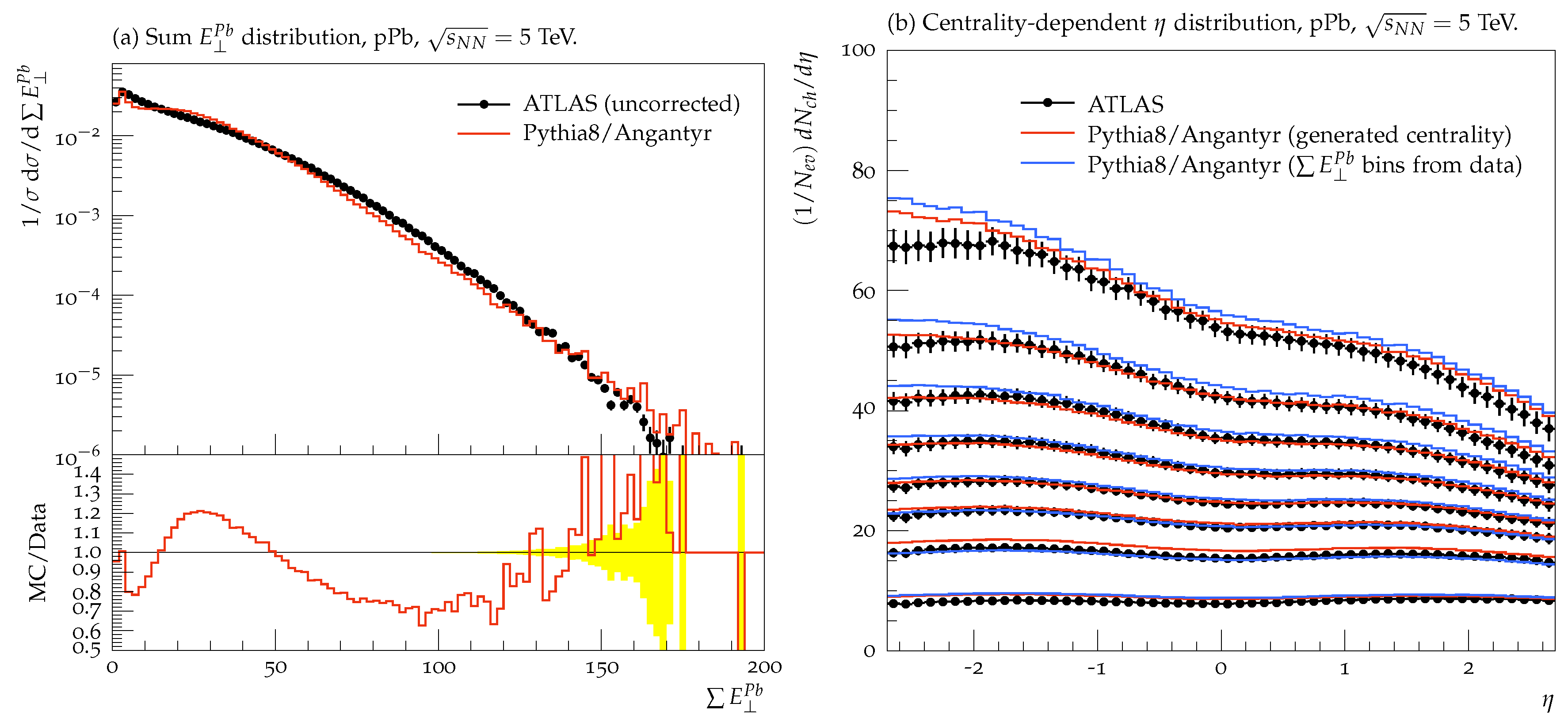The Angantyr Model for Heavy-Ion Physics in PYTHIA8 †‡
Abstract
:1. Introduction
2. Overview of the Event Generation

3. Results
3.1. pA Comparison
3.2. AA Comparison
4. Conclusions
Funding
References
- ALICE Collaboration. Enhanced production of multi-strange hadrons in high-multiplicity proton-proton collisions. Nature Phys. 2017, 13, 535–539. [Google Scholar] [CrossRef]
- CMS Collaboration. Multiplicity and rapidity dependence of strange hadron production in pp, pPb, and PbPb collisions at the LHC. Phys. Lett. B 2017, 768, 103–129. [Google Scholar] [CrossRef]
- Gleisberg, T.; Hoeche, S.; Krauss, F.; Schönherr, M.; Schumann, S.; Siegert, F.; Winter, J. Event generation with SHERPA 1.1. JHEP 2009, 2009, 007. [Google Scholar] [CrossRef]
- Bellm, J.; Gieseke, S.; Grellscheid, D.; Plätzer, S.; Rauch, M.; Reuschle, C.; Richardson, P.; Schichtel, P.; Seymour, M.H.; Siódmok, A.; et al. Herwig 7.0/Herwig++ 3.0 release note. Eur. Phys. J. C 2016, 76, 196. [Google Scholar] [CrossRef]
- Sjöstrand, T.; Ask, S.; Christiansen, J.R.; Corke, R.; Desai, N.; Ilten, P.; Mrenna, S.; Prestel, S.; Rasmussen, C.O.; Skands, P.Z. An introduction to PYTHIA 8.2. Comput. Phys. Commun. 2015, 191, 159–177. [Google Scholar] [CrossRef]
- Pierog, T.; Karpenko, I.; Katzy, J.M.; Yatsenko, E.; Werner, K. EPOS LHC: Test of collective hadronization with data measured at the CERN Large Hadron Collider. Phys. Rev. C 2015, 92, 034906. [Google Scholar] [CrossRef]
- Lin, Z.-W.; Ko, C.M.; Li, B.-A.; Zhang, B.; Pal, S. Multiphase transport model for relativistic heavy ion collisions. Phys. Rev. C 2005, 72, 064901. [Google Scholar] [CrossRef]
- Wang, X.-N.; Gyulassy, M. HIJING: A Monte Carlo model for multiple jet production in pp, pA, and AA collisions. Phys. Rev. D 1991, 44, 3501. [Google Scholar] [CrossRef] [PubMed]
- Andersson, B.; Gustafson, G.; Nilsson-Almqvist, B. A model for low-pT hadronic reactions with generalizations to hadron-nucleus and nucleus-nucleus collisions. Nucl. Phys. B 1987, 281, 289–309. [Google Scholar] [CrossRef]
- Pi, H. An event generator for interactions between hadrons and nuclei—FRITIOF version 7.0. Comput. Phys. Commun. 1992, 71, 173–192. [Google Scholar] [CrossRef]
- Alvioli, M.; Strikman, M. Color fluctuation effects in proton–nucleus collisions. Phys. Lett. B 2013, 722, 347–354. [Google Scholar] [CrossRef]
- Bierlich, C.; Gustafson, G.; Lonnblad, L.; Shah, H. The Angantyr model for heavy-ion collisions in Pythia 8. JHEP 2018, 2018, 134. [Google Scholar] [CrossRef]
- Aad, G.; Abajyan, T.; Abbott, B.; Abdallah, J.; Abdel Khalek, S.; Abdinov, O.; Aben, R.; Abi, B.; Abolins, M.; AbouZeid, O.S. et al. (ATLAS Collaboration). Measurement of the centrality dependence of the charged-particle pseudorapidity distribution in proton–lead collisions at 5.02 TeV with the ATLAS detector. Eur. Phys. J. C 2016, 76, 199, arXiv:1508.00848. [Google Scholar] [CrossRef] [PubMed]
- Aamodt, K.; Abrahantes Quintana, A.; Adamova, D.; Adare, A.M.; Aggarwal, M.M.; Aglieri Rinella, G.; Agocs, A.G.; Aguilar Salazar, S.; Ahammed, Z.; Ahmad, N.; et al. (ALICE Collaboration). Centrality dependence of the charged-particle multiplicity density at mid-rapidity in Pb-Pb collisions at 2.76 TeV. Phys. Rev. Lett. 2011, 106, 032301, arXiv:1012.1657. [Google Scholar]
- Acharya, S.; Acosta, F.T.-.; Adamova, D.; Adolfsson, J.; Aggarwal, M.M.; Aglieri Rinella, G.; Agnello, M.; Agrawal, N.; Ahammed, Z.; Ahn, S.U.; et al. (ALICE Collaboration). Centrality and pseudorapidity dependence of the charged-particle multiplicity density in Xe-Xe collisions at 5.44 TeV arXiv:1805.04432.
Publisher’s Note: MDPI stays neutral with regard to jurisdictional claims in published maps and institutional affiliations. |
© 2019 by the author. Licensee MDPI, Basel, Switzerland. This article is an open access article distributed under the terms and conditions of the Creative Commons Attribution (CC BY) license (https://creativecommons.org/licenses/by/4.0/).
Share and Cite
Shah, H. The Angantyr Model for Heavy-Ion Physics in PYTHIA8 †‡. Proceedings 2019, 10, 18. https://doi.org/10.3390/proceedings2019010018
Shah H. The Angantyr Model for Heavy-Ion Physics in PYTHIA8 †‡. Proceedings. 2019; 10(1):18. https://doi.org/10.3390/proceedings2019010018
Chicago/Turabian StyleShah, Harsh. 2019. "The Angantyr Model for Heavy-Ion Physics in PYTHIA8 †‡" Proceedings 10, no. 1: 18. https://doi.org/10.3390/proceedings2019010018





